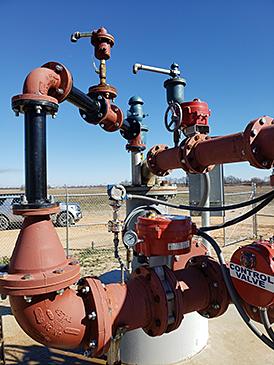Learning to Maximize Farm Profitability with Less Water
Farmland using pivot irrigation systems. (Photo by Doug Wilson)

Pumps extract water from beneath the Tallahatchie River through this wellhead and injects it into the Mississippi River Valley Alluvial Aquifer. (Photo by Matt VanHattem)
Many farmers face reduced crop yields because their water wells have trouble keeping up with irrigation demands that are taxing aquifers beyond their capacity. In fact, irrigation is no longer economically viable (or possible) in many places on the Texas High Plains and western Kansas.
Farmers and ranchers in the region depend upon the High Plains Aquifer, also known as the Ogallala Aquifer. Irrigation with water from the High Plains Aquifer, which extends from the Texas Panhandle to Nebraska and further north, represents 32% of groundwater use for agriculture and 10% of crop sales within the United States. (An aquifer is an underground body of water trapped between layers of rock or other sediment).
In many areas of the region, wells simply cannot meet the water requirements of the center-pivot irrigation systems that are widely used in agriculture. These systems feature irrigation equipment that rotates around a pivot, resulting in a circular crop field.
“Essentially, weekly water requirements to irrigate the entire field exceed what irrigators can pump, and this can result in significant yield losses for corn,” explained Robert Schwartz, soil scientist at the Agricultural Research Service’s (ARS) Conservation and Production Research Laboratory in Bushland, TX.
Schwartz and his team are investigating how producers can maximize profitability with limited water by more effectively allocating the water within their fields to one or more crops. For example, only a portion of the irrigated crop circle is planted to corn, while the rest is either planted to cotton or managed as fallow (unseeded) land. This field study limits the amount of irrigation water to 3.1 gallons per minute (gpm) per acre for the entire field, whereas the irrigation demands of corn in a “normal” year in this region is 5 to 7.5 gpm. By not irrigating a fallow part of the field and/or limiting irrigation to a drought-tolerant crop, farmers can concentrate their remaining available water on the corn so that it receives much closer to the 5 to 7.5 gpm normal requirement.
Schwartz said it’s important to understand the distinction between “deficit” and “limited” irrigation management. Under deficit irrigation, an irrigator chooses to apply less water than what is considered “optimal” for the crop; limited irrigation occurs when available irrigation water is restricted. For most of southwestern Kansas and the Texas Panhandle, producers are applying limited irrigation to corn in most years because of limitations on well yield.
Concentrating crop circle irrigation to water-sensitive crops, like corn, and applying “supplemental” irrigation to drought-tolerant crops, such as cotton, offers a way to maintain profitability under limited irrigation, Schwartz said.
Determining the bottom line under these growing conditions may seem a bit complicated because it takes several profit/expense elements into consideration. Maximum profitability in this study is based on a 120-acre irrigated area. As Schwartz explained:
-
Reducing the area planted to corn so that water can be concentrated on that smaller area will increase the yield per acre up to a certain threshold (around 250 bushels for this region).
-
Farmers are planting corn on fewer acres, so their total yield may be less than planting on more acres; however, reducing the area planted to corn also reduces seed and nitrogen input costs.
-
The remaining area (whether planted to cotton or left fallow) also has input costs, but a cotton harvest does yield additional income.
“We model the yield of corn in response to irrigation to ‘maximize’ net return of all variable costs and returns from crop receipts for the entire 120 acres,” Schwartz said. “The modeled yield for the corn at this ‘optimum’ level of planted acreage tends to be a little less than the ‘normal’ yield if you had full irrigation.”
On the other hand, yield penalties are large – 20% to 50% – when irrigation requirements are not met during critical periods when a substantial portion of the field is planted to corn, Schwartz said. “For corn, it doesn’t pay to spread out your water too much.”
Last year’s field results showed that greater net returns were obtained by allocating 84% of the available irrigation water to corn and the rest to cotton. “Corn yield was 235 bushels per acre – not bad for this very dry growing season (2.4 inches rainfall, normal is about 10 inches),” Schwartz said. – by Scott Elliott, ARS Office of Communications

